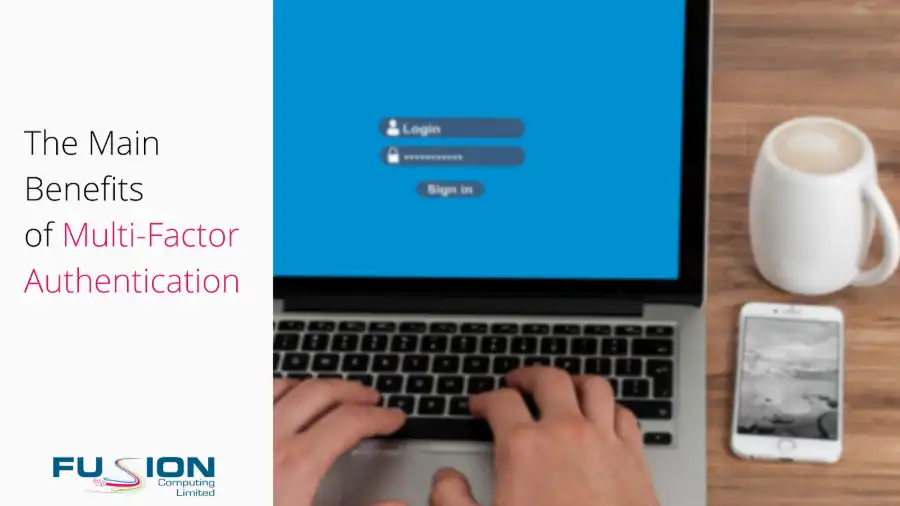Using multi-factor authentication (MFA) can prevent up to 99.9% of account hacks, says Microsoft. If that’s not enough reason for you to implement MFA in your organization, keep reading to learn about the other benefits of multi-factor authentication.
Before We Get Into the Pros and Cons of MFA, Let’s Understand What it Is
MFA is a security protocol that requires users to provide two or more pieces of information that verify their identity before they can log in.
By authenticating users in a way that is hard to trick, it serves as a critical component of a modern business’s IT security posture and helps to keep consumers’ sensitive data safe.
This authentication can come in the form of different ‘factors’, which include:
- The knowledge factor: something the users knows, like a password or secret answer
- The possession factor: something the user has, like a smartphone or a security key
- The inherence factor: something unique to the user, like a fingerprint or eye retinal pattern
MFA asks users for two or more of these factors, going beyond single-factor authentication (which usually just requires a username and password) to keep a user’s account more secure.
Hackers have become more inventive in finding ways to obtain passwords, and there is broad agreement that user accounts now require an extra level of protection to keep out unauthorized attackers.
You’ll sometimes see MFA referred to as 2FA, two-factor authentication. While MFA can include just two factors of authentication, it can also accommodate more than two factors, making MFA a more flexible option than 2FA for businesses that want additional layers of security.
(Convenience–a supposed benefit of 2-factor authentication–also makes it more vulnerable.)
Are Your Users Finding Unsecure Workarounds?Find out how you can hit the security sweet spot – maximizing protection and user compliance. |
Multi-Factoring Authentication Methods
While anyone who has logged into a service that requires MFA knows that it can be the cause of minor irritation, the benefits of multi-factor authentication for both businesses and their users far outweigh the cons.
Most importantly, it greatly reduces the risk that a hacker will gain access to a user’s account.
MFA has come to be known as a vital tool in protecting consumer data and preventing user identity theft. By adding a security key, secret answer or fingerprint scan to the login process, the chances that a hacker will be able to get past all the checks is reduced to virtually zero.
The result for businesses is that they no longer need to worry as much about their user’s accounts being breached, saving the time, money and energy that’s required to deal with the aftermath of a user’s data being exposed.
Furthermore, MFA is often an efficient way for businesses to meet industry regulations.
For example, HIPAA compliance requires that only authorized personnel have access to ePHI. Some government bodies must comply with the CJIS Security Policy, which requires MFA.
The best MFA solutions are designed to be as non-intrusive as possible, providing an intuitive user experience and including features such as remembering users so they don’t have to go through MFA each time they log in.
They can also come with single sign-on solutions, which allow users to get around without having to create multiple passwords for different applications.
And you won’t fatigue users with constantly having to enter passwords.
Other benefits of MFA include its ability to combat password fatigue by providing users with alternative ways to log in, as well as simplifying the login process by providing options such as one-time passwords that can be sent to users’ smartphones (you’re probably already familiar with Google’s Authenticator app).
Benefits of 2-Factor and Multi-Factor Authentication FAR Outweigh the Cons
While it’s true that MFA is a small hindrance for users and can represent a fairly significant cost to the business, it’s now a must-have for virtually any business that requires users to log in to its systems.
In fact, businesses operating without MFA are likely to lose consumer trust as the technology increasingly becomes the norm.
If you’re ready to get started on implementing multi-factor authentication, it’s a good idea to seek out a partner that can provide expertise in the field. There are a host of MFA options on the market, varying in cost, quality and complexity.
An IT partner can help you select and implement the solution that best suits your business, minimizing user frustration and admin overheads while maximizing the level of security.
| Safeguard Your IT Systems From Security Breaches: |
Deploying Multi-Factor Authentication Across Your Organization? You Need to Know This
While an IT partner can do the heavy lifting in deploying an MFA solution, there are some important things to remember that will make life a lot easier for you and your team.
Keep it simple: MFA does not need to be dreaded by the IT department. The best solutions are easy to deploy and manage and work within your existing IT environment.
Balance security and ease-of-use: It’s tempting to take information security to the max and go with a complex solution that requires more than two factors. You should try to find the balance between what will turn off users and what will keep them adequately secure.
Get leadership buy-in for MFA: Executives can be cold to MFA because it gets in the way of users doing what the business wants them to do. Explain that you are implementing MFA in the most seamless, user-friendly way possible.
We Help Businesses Like Yours Take Full Advantage of MFA and 2-Factor Authentication
Fusion Computing is a leading Toronto IT service provider and we know all there is to know about multi-factor authentication. Contact us today to learn more about MFA and how it can keep your users secure while removing the headaches that come with data breaches.


